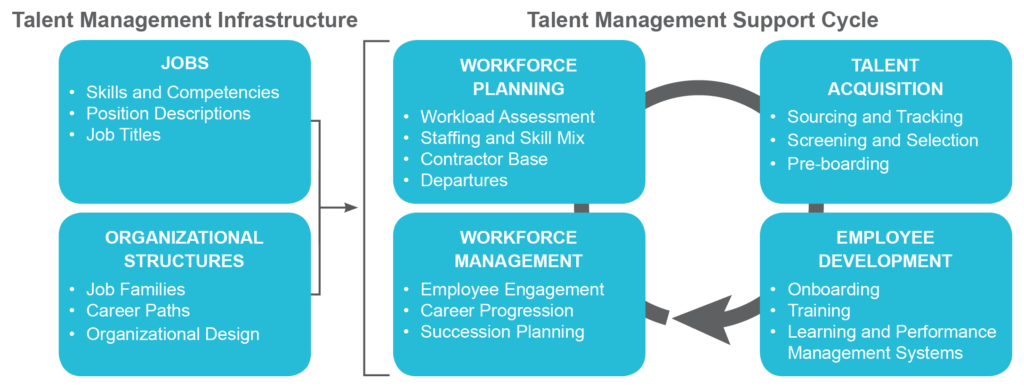
This article is the first article of a three-part series focused on managing talent struggles. To access additional articles in the series, please see below.
Part 2: How to Attract the Right Talent
Part 3: Managing the Generational Gap
Introduction
The fight for talent has been a top-trending discussion topic in many HR-related publications, blogs, and conferences. Anticipated retirements are increasing while the need for new talent in technical roles is growing. In addition, generational differences are presenting workforce challenges that organizations must learn to manage. The challenges in this multi-generational dynamic are retaining and engaging younger staff, while imploring older staff to commit to transferring their knowledge. All of these talent concerns aren’t just a focus of HR leaders, but are also the number-one global concern for CEOs according to a recent Harvard Business Review[1] essay. Many of the CEOs interviewed stated human capital challenges are related to operational achievement. Successful recruitment and development of talent increases operational excellence and innovation and improves customer relationships.
ScottMadden believes HR organizations are well positioned to enable companies, strategically and operationally, to navigate these current talent struggles successfully. In this first article of a three-part series, ScottMadden will discuss workforce planning and how HR organizations can address many of their talent struggles. The series will continue by addressing the topics of attracting the right talent and succession planning.
Planning the Workforce
Many companies spend time conducting annual planning for their future workforce needs. However, workforce planning is not effective unless the plan is linked to recruiting efforts and development of internal resources. To manage talent effectively, all components of the talent management cycle must be linked, as shown in Figure 1. In our experience, this is where companies fall short when executing their workforce plan.
Figure 1: ScottMadden’s Talent Management Framework

When a business develops its workforce plan, it must start with the long-term strategic goals of the company. These goals provide an organization with the road map on which to base resource planning. For example, an organization planning to grow significantly will have different needs from one whose strategy is to reduce operational expenses to alleviate cost pressures. By comparing the capabilities of current resources to future needs, companies are then able to map resource requirements based on staff, position, skill set, location, geography, cost to acquire, and ease of development. Companies should particularly focus on projecting workforce retirement, critical position succession plans, upcoming expansion opportunities, and expected turnover outside of retirements.
Anticipating Worker Retirements
It is important to note that comparing future needs with current state capabilities will allow for other important analyses critical to the workforce plan. One such analysis focuses on anticipating worker retirements. Companies have used multiple approaches to project retirements accurately. Several companies have directly asked all employees, “What do you plan to do in the next two to three years?” These companies are able to gauge retirement levels more effectively. However, this approach is only successful if employees do not feel they will be viewed differently upon reporting their retirement plans. At other companies, similar data is gathered through anonymous surveys.
Using Contractors and Outsourcing Effectively
A second important analysis determines how the company would like to use external resources, such as contractors, outsourcing partners, and other “buckets” of talent that can supplement the employee base. Contractors and outsourcing can be effective when used for the right reasons.
Contractors are ideal for short, project-based work efforts in which the contractor supplies unavailable critical skills or expertise or when manpower is needed for a defined period of time. Yet, when contractors are used excessively, companies lose competencies and skills that they may not be able to re-acquire. Additionally, when contractors shift from defined projects to long-term staff augmentation roles, a company’s costs can increase significantly. Without the proper controls, it is not unusual to see contractors perform a set of non-project-based work activities continuously for years.
Outsourcing can also be an effective way to manage workload. However, companies should be cautious about the work they choose to outsource. When effectively deployed, outsourcing should involve either non-strategic work activities or those for which the company lacks expertise or scale. Management must provide governance and oversight of the outsourced service provider using proper controls, a defined scope of work, and a projected timeline.
Establishing Required Skill Sets
A third analysis establishes the competencies and skills needed for the future work environment. Future state core competencies and skills will need to be redefined from those historically valued to close identified gaps. This analysis will help inform training and hiring needs related to the plan.
Upon completion of the workforce plan, companies should ensure that all stakeholders are on board with the plan and its components. This will help prevent deviations from the plan and ensure recruitment activities are targeted appropriately. Following this proven ScottMadden approach for workforce planning will help organizations be positioned for success in overall talent management.
Are you ready to transform your talent management practices? Since many companies are facing extraordinary talent challenges, you can’t afford to wait. The companies that approach talent strategically and tactically while implementing a thorough action plan will have better chances for increased progress and success.
Get started with our sophisticated Talent Management Assessment. The assessment enables you to:
To learn more about our talent management assessment contact us at info@www.scottmadden.com.
[1] (Boris Groysberg, The 3 Things CEOs Worry About the Most, 2015)
View MoreSussex Economic Advisors is now part of ScottMadden. We invite you to learn more about our expanded firm. Please use the Contact Us form to request additional information.